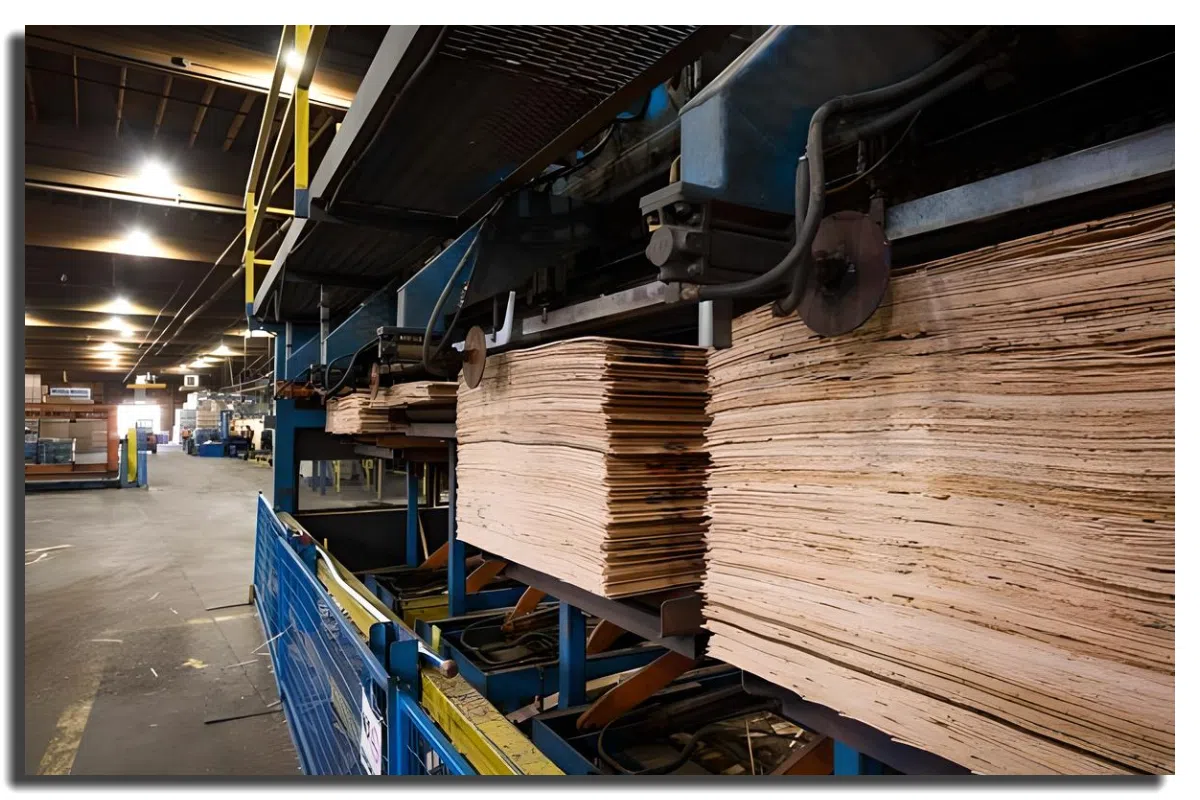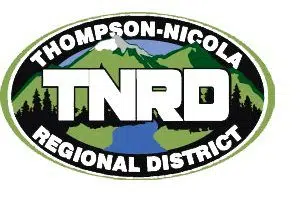
US President Donald Trump/via Whitehouse.gov
A not-so-veiled warning that layoffs are likely to come in the BC forest industry, as the US President has pointed specifically at this province while making his move to hit this country with massive sanctions.
“This tariff on all forest product exports will be devastating, potentially leading to further job losses hurting the workers and communities across the province that depend on forestry,” warned the BC Council of Forest Industries in a statement issued after the impostion of the new round of punishment by the Trump administration on Saturday.
As threatened, a 25% — across the board — tariff on all Canadian products crossing the border into the United States was signed into law on February 1st.
While a blow for virtually all sectors across the country which have large export markets in the United States, the forest sector is going to be particularly impacted, thanks to Section 2, part (c), of the Order.
“(c) The rates of duty established by this order are in addition to any other duties, fees, exactions, or charges applicable to such imported articles.”
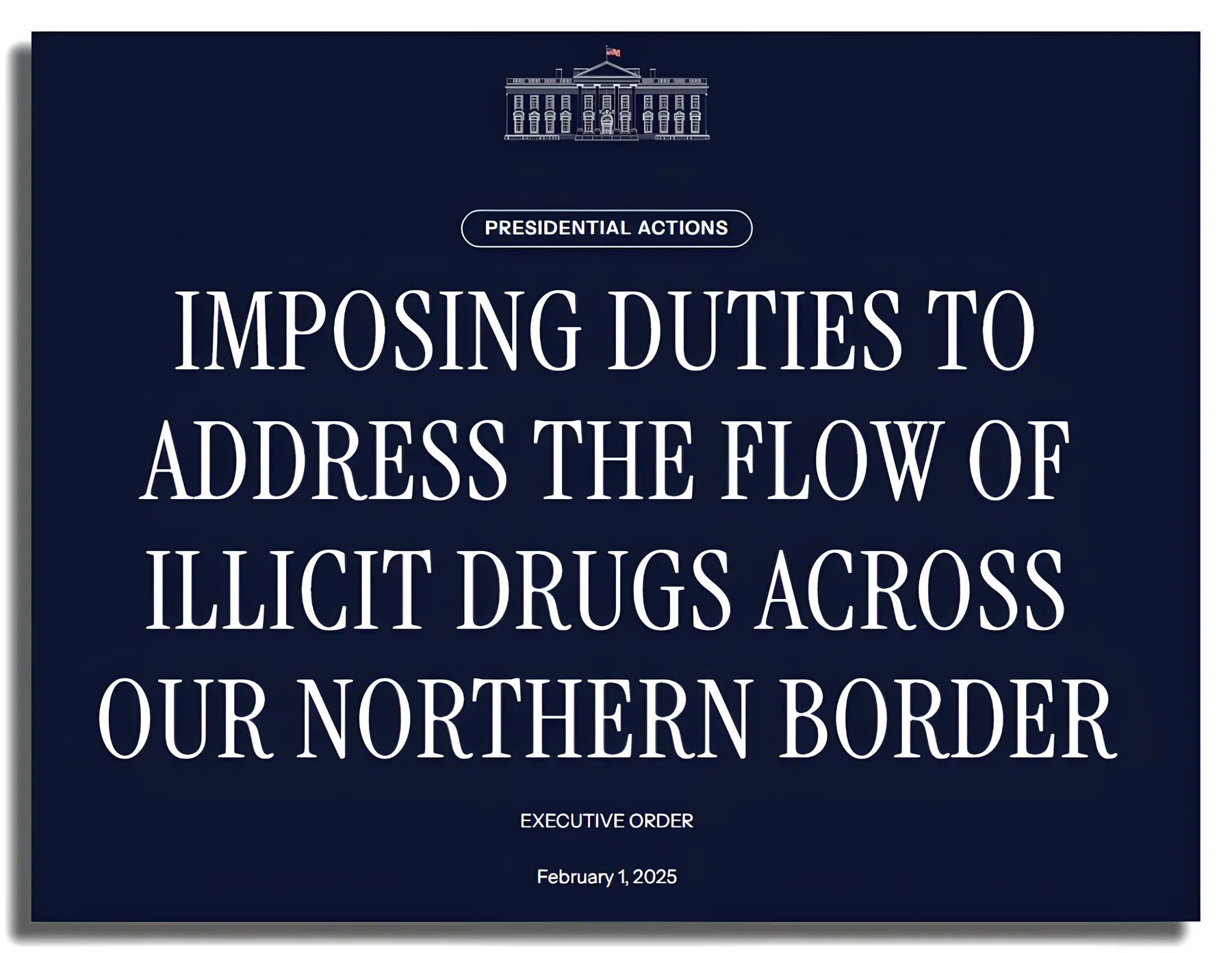
Notification on the White House website notifying the imposition of tariffs on Canada/via Whitehouse.gov
This would suggest the new 25% tax on BC exports is going to be added to the existing tariffs the US Commerce Department already has in-place for Canadian softwood exporters.
Vernon-based Tolko, owner-operator of the Heffley Creek Mill in Kamloops, will see — as one example — the cost to ship its products into the United States jump from the recently “revised” rate of 17.27% to a massive hit of 42.27%.
While somewhat complex, the new tariffs essentially means that for ever $100 U.S. worth of product — such as plywood and veneer in the case of Heffley Creek — $42.27 US dollars has to be paid by Tolko to get its products into the United States — and not on an I-owe-U basis.
These are cash deposits which have to be given to US Customs before hand or during the transaction to allow the product to get in.
They’re in place to ensure that fees are eventually paid once an appeals process — launched by the Canadian government on behalf of the domestic lumber industry — is concluded.
The latest review of softwood lumber tariff rates are set to be released on February 20th, which is only a few months after the most recent hikes became permanent.
Current “final determination” penalties took effect on September 24th, 2024 — the culmination of the 5th review in the long-standing trade conflict, which dates back over 40 years, but began flaring up again in 2016.
Even before the announcement on Saturday that the new Trump tariffs were taking effect, Tolko had already seen its cost of doing business at the US border jump from just over 8% to the 17.27% made public in late September.
While challenging for any company, the ability of certian companies such as Tolko to find available cash streams is likely going to be hindered by the fact its a privately-held company, and thus doesn’t have access to the financial markets for a cash infusion.
Canfor highlights recent, expected struggles
Tolko was one of the original companies which had a finger pointed at it for review during the current 9 year phase of the softwood lumber dispute.
But the one company that has had a bullseye on its back since the beginning of the fight in the 80’s has been Canfor, BC’s largest operator in the forest sector.
In Canfor’s case specifically, even selling off a chuck of its own assets wasn’t enough to make up for a back-dated bill the company had to end up paying recently to keep its supply lines to the US open.
Canfor slashed around 500 jobs in northeastern BC in early September, announcing the permanent closure of its operations in Fort St. John and Vanderhoof on September 4th.
“On September 9, 2024, the Company completed the sale of its remaining Mackenzie sawmill assets and associated forest tenure to the McLeod Lake Indian Band and Tsay Keh Dene Nation for total proceeds of $66.5 million,” noted Canfor in its 2024, third-quarter (Q3) review for investors.
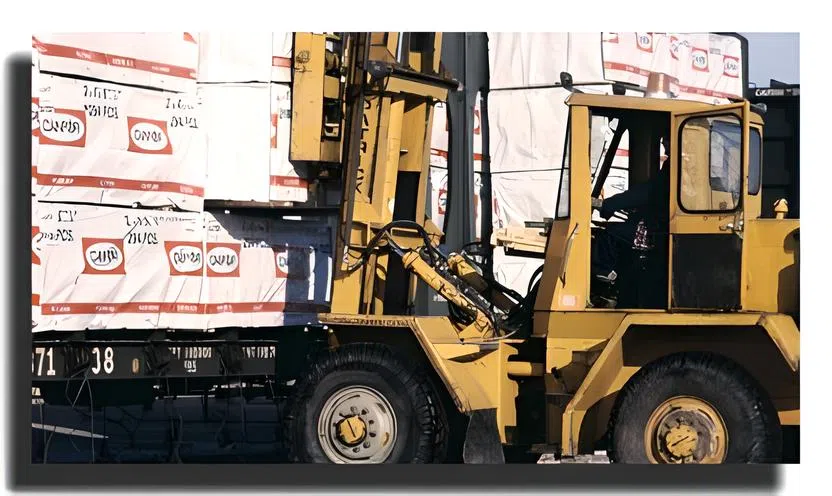
Load of plywood being unloaded from a truck at Canfor’s operation in Fort St. John, c.1981/via Canfor
One line later in the report, Canfor revealed those proceeds were quickly absorbed by a US Customs bill that ended up costing the company more than it made with the sale in MacKenzie.
“A duty expense of $67.2 million (US$48.6 million) was recognized in Q3 2024 following the finalization of countervailing (“CVD”) and anti-dumping duty (“ADD”) rates applicable to the fifth period of review,” said the quarterly synopsis.
That $67.2 million was a one-off payment made to US Customs related to calculations based on appeals and reassessments of previous duties.
Canfor’s financial statments show the company has been leaving an average of $12 to $13 million at the US border every three months in tariffs, but at a rate of 6.61% — not the 41.58% the company is faced with now.
The BC lumber giant — which employs around 6,000 people throughout its operations — reported 3rd quarter losses last year of $547 million.
That’s up from the $356 million the company had lost during the same period in 2023.
BC called out specifically in Trump order
While it’s not exactly a “smoking gun” as far as evidence goes, Donald Trump’s Executitive Order did focus on concerns raised about the level of illicit drugs finding their way from Canada into the United States.
“Canada’s Financial Transactions and Reports Analysis Centre recently published a study on the laundering of proceeds of illicit synthetic opioids, which recognized Canada’s heightened domestic production of fentanyl, largely from British Columbia, and its growing footprint within international narcotics distribution,” claimed Trump’s Executive Order he signed on Saturday.
“Despite a North American dialogue on the public health impacts of illicit drugs since 2016, Canadian officials have acknowledged that the problem has only grown,” claimed the White House. “While U.S. Customs and Border Protection (CBP) within the Department of Homeland Security seized, comparatively, much less fentanyl from Canada than from Mexico last year, fentanyl is so potent that even a very small parcel of the drug can cause many deaths and destruction to America families.”
The summary goes on to claim the amount of fentanyl seized at the Canada-US order would likely have killed 9.5 million Americans.
“Immediate action is required to finally end this public health crisis and national emergency, which will not happen unless the compliance and cooperation of Canada is assured,” proclaimed the new Executive Order.
The order itself is written in a loose language, which could allow the US President to continue hitting Canada for quite some time with financial penalties.
The new Secretary of Homeland Security is going to take the lead on derminiing when, how or if the 25% tariff remains in effect.

US Homeland Security Secretary Kristi Noem at a rally for now-US President Donald Trump/via Scientific American
“The Secretary of Homeland Security shall regularly consult with the Secretary of State, the Attorney General, the Assistant to the President for National Security Affairs, and the Assistant to the President for Homeland Security on the situation at our northern border,” stated the beginning of Section 3 of the document, which also talks of remedies, but also warns about further action if Trump sees fit.
“The Secretary of Homeland Security, in coordination with the Secretary of State, the Attorney General, the Assistant to the President for National Security Affairs, and the Assistant to the President for Homeland Security, shall recommend additional action, if necessary, should the Government of Canada fail to take adequate steps to alleviate the illegal migration and illicit drug crises through cooperative enforcement actions,” the document adds.
The document does not provide any metrics as to what would constitute “adequate steps” to persuade the US President to change his mind on the tariffs.
As for the new Secretary of Homeland Security, Kristi Noem, the former governor of South Dakota is socially conservative, but did reportedly push back against financial policies that Trump was making during his first term which impacted her state.
Trump cites just over week-old report as reason for anger with Canada
In turning on the hydrdant with no one at the front of the hose, the US President did point to a recent report by FINTRAC as being part of the rationale behind making his decision to launch the tariffs.
The Financial Transactions and Reports Analysis Centre of Canada (FINTRAC) did issue a recent Operational Alert about the status of drugs and drug smuggling in Canada and North America.
A joint study conducted by FINTRAC, through the collaboration of CIBC, Canada Post, the Canada Border Services Agency (CBSA), the RCMP and the United States government’s own Department of Homeland Security Investigations branch authored the report, which does call out British Columbia specifically in connection with fentanyl production.
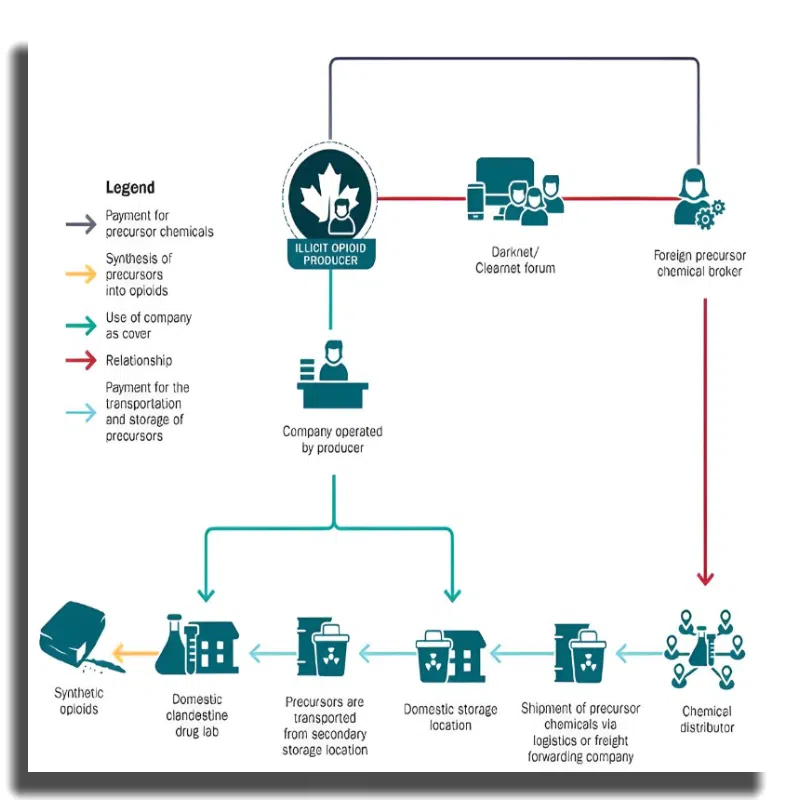
Graphic details flow of synthetic drugs through Canada/via FINTRAC
“According to Canadian law enforcement officials, several domestic groups are suspected of playing an increasing role in the fentanyl market in Canada, with the majority operating in British Columbia as producers and distributors and with the majority of fentanyl precursor shipments being destined for that province,” noted the FINTRAC report.
Rather than it being a piece of damning evidence against Canada and percieved mismanagement of the border, the report is almost exclusively focused on ways in which international criminal organizations are moving money.
This includes the different avenues that higher-level drug producers are taking to avoid detection in through the current financial transation laws and guildlines, such as “cash Smurfing.”
This involves making large quantities of cash smaller, while spread it through a wide variety of intermediaries to avoid setting off the standard banking red-flags.
The report also says that a lot of the drug trafficking that’s being done in BC would seem to be flowing through Kamloops, with this city being a potential ‘branching off’ location that investigators have been able to track using banking transactions.
“In Canada specifically, point-of-sale and automated teller machine transactions provided geographic indications that opioids primarily move inland from distribution hubs in Vancouver, British Columbia,” noted the analysis.
“From Vancouver, supplies are distributed to Calgary or Edmonton and then to Saskatchewan.”
The report is an update to a previous piece of analysis done by the same collection of players, including US Homeland Security, in 2018 through what’s known as Project Guardian.
While this report may well have provided the influence needed to push the US President over the top when it comes to his desire for tariffs to protect his country from opiods, it almost certainly was not the catalyst.
This report was made public on January 23rd, 2025 — just over a week before Trump signed the Executive Order, and well after he began levelling his threats of tariffs against Canada and Mexico.
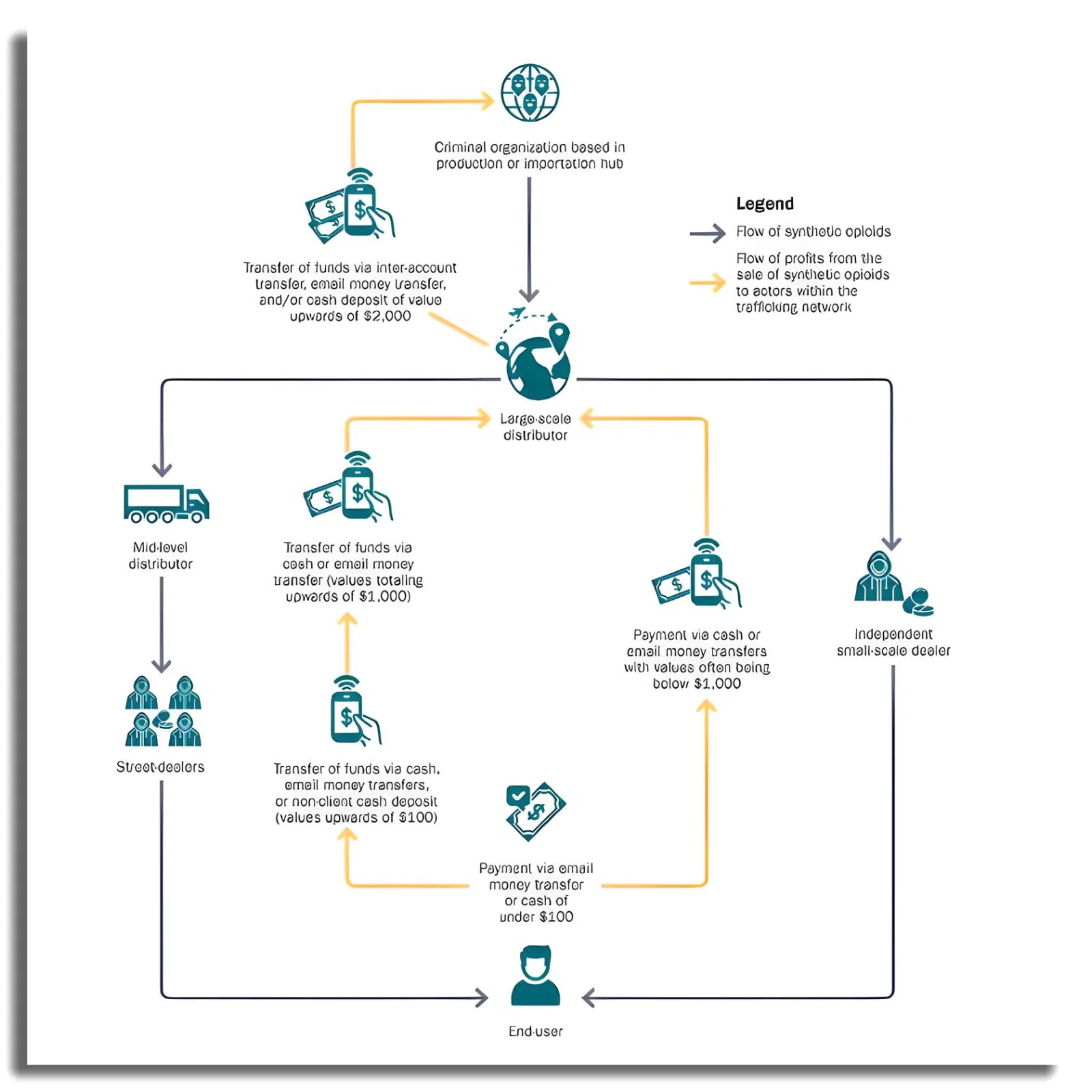
Graphic details flow of synthetic drugs through Canada/via FINTRAC






